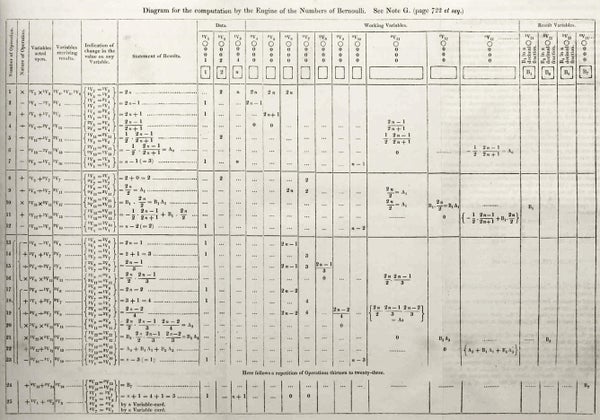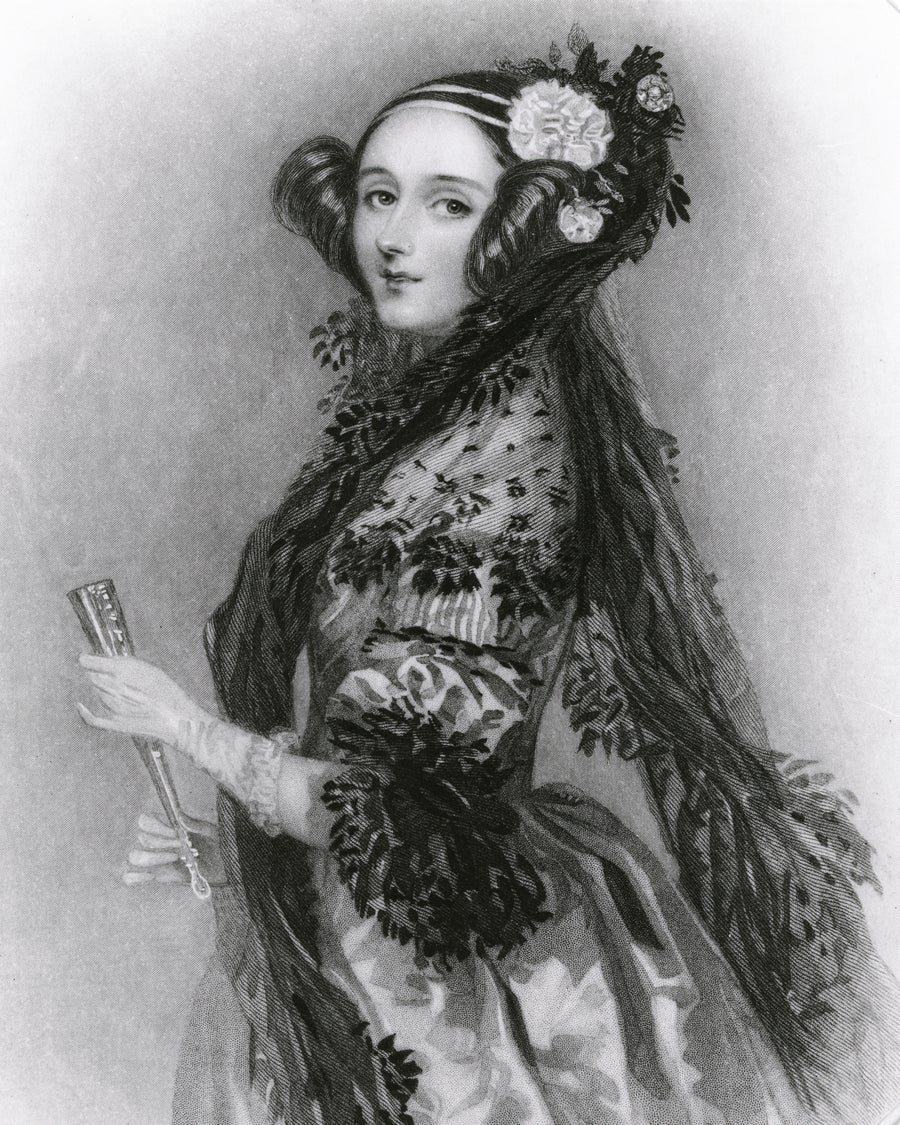The 180-Year-Old Endnotes That Foretold the Future of Computation
Ada Lovelace’s wisdom about the first general-purpose computer can be found buried in the appendix of another paper

This diagram shows an algorithm for the analytical engine for the computation of Bernoulli numbers, taken from the article Sketch of the Analytical Engine Invented by Charles Babbage, written by Luigi Menabrea with notes by Ada Lovelace.
The Picture Art Collection/Alamy Stock Photo
Many fields of science can point to a foundational document: Isaac Newton’s Principia for the physics of classical mechanics or Charles Darwin’s On the Origin of Species for evolutionary biology. But only computer science can claim its foundational document hides in the endnotes.
Augusta Ada King, Countess of Lovelace, better known as Ada Lovelace, was commissioned in 1842 to translate a paper about the world’s first general-purpose computer. She appended her own annotations, which ran three times longer than the original article and completely eclipsed it in terms of technical meat and philosophical insights. With impressive foresight, they established her as the first person to envision the universal capabilities of computers that we take for granted today.
Though the whole world knows of Lovelace’s dad, she never knew him personally. Lord Byron, celebrated for his Romantic poetry, was by all accounts a rotten husband and absent father. (After first meeting Lord Byron in 1812, aristocrat Lady Caroline Lamb apparently called him “mad, bad and dangerous to know.”) Lovelace’s parents’ brief and tumultuous marriage ended with Lady Byron, née Annabella Milbanke, accusing him of abuse and infidelity a mere five weeks after his daughter’s birth. Although they never met again, Lord Byron had at least two lasting effects on his daughter. For one, she maintained a curiosity about him and his work and perceived much of her later scientific worldview through a poetic lens. Second, Lady Byron believed that she could shield Lovelace from inheriting her father’s erratic temperament by steering her away from literary studies and instead fostering her interest in science and math.
On supporting science journalism
If you’re enjoying this article, consider supporting our award-winning journalism by subscribing. By purchasing a subscription you are helping to ensure the future of impactful stories about the discoveries and ideas shaping our world today.
The defining partnership of Lovelace’s intellectual life would come through polymath Charles Babbage, whom she met at age 17. In 1833, the year that they met, Babbage had begun designing the first general-purpose mechanical computer, called the analytical engine. The idea captivated Lovelace, and the two became close friends and collaborators.
Had he ever managed to build it, Babbage’s analytical engine would have been a marvel to behold. Sketches and spec sheets depict an intricate beast with rattling gear columns towering 15 feet high, lever panels cranking in lockstep and thousands of moving parts churning together in a sort of steampunk orchestra. Although unrecognizable as your laptop’s ancestor, the device remarkably contained most of the same components that we know in modern computer architecture. It had a central processing unit called a mill to carry out arithmetic operations, memory storage, input capabilities to read data and programs, and even a printer.

Ada Lovelace, shown here in this portrait, is sometimes called the world’s first computer programmer.
API/Gamma-Rapho via Getty Images
Keep in mind that the era predated electronics, so steam would have powered all of this functionality. Every gear column stacked 40 gears with 10 teeth each labeled 0 through 9 for storing a 40-digit number, much like the disks on a combination lock. The mill could crunch these numbers through complicated procedures of rotating and swapping gears. But the secret sauce that separated the analytical engine from its predecessors was that it was programmable.
The design drew inspiration from the Jacquard machine, which attached to a loom and disrupted the 19th-century textile industry by automating weaving through punch card technology. Like the Jacquard machine, the analytical engine could have read instructions in the form of holes punched into card stock. Babbage had built a prototype for an earlier device called the difference engine (currently on display at the Museum of Science in London), which could mechanically calculate a preset suite of operations such as certain logarithms and trigonometric functions. He abandoned it because he saw greater potential in a machine that could be programmed to perform arbitrary calculations.
Programmability elevates a machine from a mere calculator to a computer. The analytical engine would have been able to choose which instruction to follow based on the outcome of a previous computation—a skill called conditional branching. This capability would have allowed the machine to carry out advanced instructions such as if-else statements and loops seen in today’s programming languages. Although Babbage understood the power of programmability, he still viewed the analytical engine as a purely mathematical device. Only Lovelace foresaw the true potential in the computer.
Ten years after Lovelace first learned of the analytical engine, she was commissioned to translate a paper on the topic written by mathematician and engineer Luigi Federico Menabrea (who would go on to be Italy’s seventh prime minister). Possessing much more detailed knowledge of the engine than Menabrea, Lovelace corrected his errors and added seven of her own endnotes, which alone constitute a watershed document in the history of computation.
Many retrospectives focus on “Note G” because it contains the first published computer program. Lovelace’s program calculates Bernoulli numbers, which play a critical role in a branch of math called analysis. Her calculation method used more computational steps than necessary, but she chose this tack deliberately to show off the power and flexibility of the machine. Although many credit her as the first computer programmer, some historians contend that unpublished programs predated her notes and that technically Note G doesn’t contain a program as we’d name it today but rather an execution trace—a record of every operation performed during the execution of a program. I find such quibbles moot because I’d argue that the moniker “first computer programmer” undersells the wisdom found in the rest of her notes.
Babbage saw the analytical engine as a mathematical device. After all, it primarily stored and operated on numbers. But Lovelace recognized that a machine designed to crunch numbers could do much more if the numbers represented other things. For example, she wrote in the endnotes, “Supposing, for instance, that the fundamental relations of pitched sounds in the science of harmony and of musical composition were susceptible of such expression and adaptations, the engine might compose elaborate and scientific pieces of music of any degree of complexity or extent.” Now, some 180 years later, generative artificial intelligence tools such as Suno and Udio can compose music from text-based prompts.
Lovelace’s insight marks a profound conceptual leap that wouldn’t be formalized for another century with the work of Alan Turing: Fundamentally, computation involves the manipulation of symbols according to rules. There’s no limit on what those symbols represent. This idea is built into Turing’s mathematical model of computation, and it originated with Lovelace. We take for granted today that the same bits of 0’s and 1’s encode every type of media—text, images, audio, video—but it’s hard to fathom that this future had been envisioned before the first computer had even been built.
Lovelace also explicitly discussed artificial intelligence, kicking off a debate that defines the modern era. She concluded in her endnotes that the analytical engine would not be intelligent because it wouldn’t originate anything, arguing that “it can do whatever we know how to order it to perform.” Turing challenged Lovelace by name in his seminal paper on “thinking machines.” Though he conceded that computers merely do what they’re told, Turing suggested they still have the power to surprise us. Turing acknowledged that Lovelace never had an opportunity to interact with a computer and so lacked the advantage of experiencing such surprise for herself. In today’s AI landscape, many now believe that machines can exhibit intelligence (although holdouts from Lovelace’s camp are not hard to find). The fact that Lovelace even entertained the question of whether a clanging heap of cogs that had only been sketched on paper would be intelligent shows how ahead of her time she was.
Ultimately Babbage’s contentious relationship with the British government meant that he never secured enough funding to bring the analytical engine to life. It’s funny to contrast Lovelace’s prophetic words about the potential of computers with a quote from the U.K.’s then prime minister Robert Peel: “What shall we do to get rid of Mr. Babbage and his calculating machine? Surely if completed it would be worthless as far as science is concerned?”

